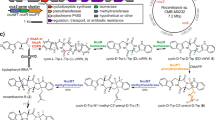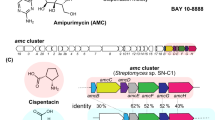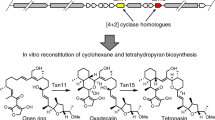Abstract
Teleocidin B, with its unique indolactam-terpenoid scaffold, is a potent activator of protein kinase C. This short review summarizes our recent research progress on the biosynthesis of teleocidins in Streptomyces blastmyceticus NBRC 12747. We first identified the biosynthetic genes for teleocidin B, which include genes encoding a non-ribosomal peptide synthetase (tleA), a cytochrome P450 monooxygenase (tleB), an indol prenyltransferase (tleC), and a C-methyltransferase (tleD). Notably, the tleD gene is located outside the tleABC cluster. Our in vivo and in vitro analyses revealed that TleD not only catalyzes the C-methylation of the prenyl chain but also produces the indole-fused cyclic terpene structure. This is the first report of terpene cyclization initiated by the C-methylation of the prenyl double bond. In contrast, TleC catalyzes the geranylation of the C-7 position of the indole ring, in the reverse fashion. Our X-ray crystallographic analyses provided the structural basis for the reverse prenylation reactions, and structure-based mutagenesis successfully resulted in the production of unnatural, novel prenylated indolactams.
Similar content being viewed by others
Introduction
Teleocidin B (1) (Fig. 1), an indolactam-terpenoid hybrid molecule, was initially isolated from Streptomyces mediocidicus [1,2,3,4,5] and reported to be a potent activator of protein kinase C [6]. Owing to its unique structure and remarkable biological activity, it has been extensively studied by many chemists and biochemists. Its biosynthesis has also been investigated by isotope-feeding and chemical conversion experiments, which revealed that this molecule is synthesized from L-valine and L-tryptophan, through the formation of indolactam V (2), and the isoprenoid moiety is generated by the 2-C-methyl-D-erythritol 4-phosphate pathway [7,8,9]. However, the genes and enzymes involved in the construction of this unique, indole-fused cyclic terpenoid structure remained to be elucidated. Therefore, to understand the molecular basis for teleocidin biogenesis, we performed the genome mining of its biosynthetic gene cluster.
Identification of biosynthetic genes
In 2004, the biosynthetic gene cluster (the ltx cluster) of lyngbyatoxin A (3) (Fig. 2) [10], which is a putative precursor of teleocidin, was identified from the cyanobacterium Moorea producens [11]. The ltx gene cluster encodes the non-ribosomal peptide synthetase (NRPS) LtxA, the cytochrome P450 monooxygenase LtxB, and the indole prenyltransferase (PT) LtxC. This established that the biogenesis of lyngbyatoxin A starts with the formation of the dipeptide N-methyl-L-valine-L-tryptophanol (4) by the NRPS LtxA, followed by the subsequent cyclization by the P450 LtxB into the indolactam V (2) through a unique oxidative C-N bond-forming reaction and the reverse-fashion geranylation of the indolactam by the indole PT LtxC (Fig. 2) [12]. However, the biosynthesis of the teleocidins, with the characteristic indole-fused C11 carbocycle, still remained to be elucidated.
Since lyngbyatoxin A is thought to be a precursor of teleocidins, we first searched for homologs of the ltx gene cluster in the genome sequence of Streptomyces blastmyceticus NBRC 12747, which produces teleocidin B [13]. As a result, we identified one candidate gene cluster (the tle cluster) in a 23.2 kb contig, encoding the NRPS TleA (49% identity with LtxA), the P450 TleB (47% identity with LtxB), and the PT TleC (40% identity with LtxC). Unexpectedly, no methyltransferase (MT) or terpene cyclase genes, which we thought would be involved in the biosynthesis of teleocidin, were present in the cluster. In fact, heterologous gene expression of the tleABC cluster, in Streptomyces lividans TK21 as the host strain, resulted in only the production of lyngbyatoxin A (3) but not teleocidins, suggesting that the additional genes encoding the enzyme(s) for the C-methylation and terpene cyclization reactions are located outside of the tleABC cluster [13, 14]. A sequence analysis revealed that there are nine C-methyltransferase (C-MT) genes in the S. blastmyceticus genome, and a reverse transcriptase–polymerase chain reaction experiment indicated the co-transcription of six of them with tleC. Therefore, we tested the co-expression of each of the six C-MT genes with the tleABC genes in S. lividans and finally identified tleD as the C-MT gene responsible for the production of teleocidins [13]. Notably, TleD is moderately homologous to other S-adenosyl-L-methionine (SAM)-dependent C-MTs that mediate the C-methyl transfer reaction to the prenyl carbons [15,16,17]. Finally, the co-expression of all four tleABCD genes in S. lividans successfully resulted in the production of teleocidin B-1 (1a), teleocidin B-4 (1d), and des-O-methyl-olivoretin C (5) (Fig. 3) [13, 14].
Terpene cyclization initiated by methyl transfer
It is remarkable that the co-expression of the tleD gene with the telABC genes led to the formation of not only methylated but also cyclized products. This was also confirmed by in vitro enzyme reactions. The C-MT TleD was heterologously expressed in Escherichia coli as a soluble protein, and the purified recombinant enzyme successfully accepted lyngbyatoxin A (3) as a substrate to efficiently produce the three cyclized products: teleocidin B-1 (1a), teleocidin B-4 (1d), and des-O-methyl-olivoretin C (5), as in the in vivo case [13]. This result unequivocally established that 3 is the direct precursor of teleocidins, and TleD not only catalyzes the C-methylation of the geranyl side chain but also produces the indole-fused cyclic terpenoid (Fig. 3). This is the first report of a terpene cyclization reaction initiated by the C-methylation of the prenyl double bond: a C-methylated carbocation thus triggers the nucleophilic attack on the same carbon from the C-7 position of the electron-rich aromatic ring to form the characteristic indole-fused C11 carbocycle scaffold of teleocidins.
Interestingly, the TleD enzyme reaction with [25-2H]-3 demonstrated that the 2H atom is retained in all three products, 1a, 1d, and 5, and that the 2H atom at C-25 migrated to C-26 (Fig. 3) [13]. This indicated that a 1,2-hydride shift proceeds to generate the C-25 tertiary cationic intermediate, and since no isotope enzyme kinetic effect was observed, this is not the rate-determining step of the enzyme reaction. Based on these observations, we proposed the following mechanism of the TleD enzyme reaction (Fig. 3), which is consistent with the previous proposal by Irie and co-workers [7,8,9]. TleD first catalyzes the C-methylation of C-25 of the terminal double bond, and a subsequent 1,2-hydride shift produces the C-25 carbocation, which is then converted to a spiro-fused cationic intermediate by the Re-face nucleophilic attack from the indole ring. Finally, the carbon rearrangement via path a yields 1d, whereas that by path b produces 5. In contrast, the Si-face nucleophilic attack from the indole during the formation of the spiro intermediate (path c) leads to the production of 1a. Both the in vitro and in vivo reactions afforded the same product ratio (1a:1d:5 = 1:5:2), indicating that path a is preferred [13]. This is probably due to the steric effects caused by the presence of the bulky isopropyl and vinyl substituents. Presumably, the 1,2-hydride shift and the terpene cyclization proceed in a concerted manner, since no products derived from the hydroxylation or deprotonation of the C-25 carbocation were detected in the reaction mixture. Nonetheless, it should also be noted that we cannot totally exclude the possibility that TleD simply catalyzes the C-methylation, while the remaining reactions do not require much enzymatic assistance and could proceed almost spontaneously.
The amino acid sequence of the 32 kDa SAM-dependent C-MT TleD showed 17%, 28%, and 34% identities to those of Streptomyces coelicolor A3(2) geranyldiphosphate 2-C-MT [15], M. oryzae sterol 24-C-MT [16], and Lechevalieria aerocolonigenes rebeccamycin sugar 4’-O-MT RebM [17], respectively. However, it lacks homology to any known terpene cyclizing enzymes. Recently, He and co-workers reported the X-ray crystal structures of TleD in complex with the SAM analog, S-adenosyl-L-homocysteine, in the presence and absence of lyngbyatoxin A (3) [18]. The structures revealed that, in TleD, Tyr21 anchors a unique additional N-terminal α-helix to the core structure of the SAM-dependent C-MT fold and plays an important role in the catalytic function. Furthermore, a molecular dynamics simulation suggested that the folding conformation of the enzyme-bound substrate 3 facilitates the Re-face nucleophilic attack from the C-7 carbon of the indole ring, during the formation of the spiro-fused cationic intermediate. This is consistent with our observed product ratio of 1a:1d:5 [18].
Prenylation of indolactam by aromatic PT
In the biosynthesis of teleocidins, lyngbyatoxin A (3) is produced by the 42 kDa soluble indole PT, TleC. In fact, our in vitro and in vivo experiments confirmed that TleC accepts indolactam V (2) and GPP (C10) as substrates and catalyzes the Friedel–Crafts alkylation at the C-7 position of the indole ring in a reverse fashion (C-C bond formation at the C-3 position of the prenyl chain) to produce 3 (Fig. 4) [19]. Interestingly, TleC shares 38% identity with another indole PT, MpnD, from the bacterium Marinactinospora thermotolerans [20], which also selects 2 as the prenyl acceptor to catalyze the prenylation of DMAPP (C5) in the reverse manner to yield pendolmycin (6) (Fig. 4). The two enzymes thus catalyze the prenylation of the same acceptor substrate with different prenyl chain lengths. Furthermore, the in vitro enzyme reactions revealed that, while each enzyme prefers different prenyl donors (C10 for TleC and C5 for MpnD), both TleC and MpnD can accept prenyl donors with chain lengths varying from C5 to C25. Interestingly, MpnD catalyzes the prenylation of GPP in the forward fashion at the C-5 position of the indole, to afford the 5-geranylindolactam V in addition to 3 [19].
To understand the structure–function relationships between the two indole PTs, we successfully solved the X-ray crystal structures of both TleC and MpnD at 1.4–2.1 Å resolutions (Fig. 5) [19]. The apo and the complex structures with the DMAPP analog, dimethylallyl S-thiopyrophosphate, and indolactam V (3) revealed that these two enzymes share an almost identical αββα (ABBA) barrel overall fold [21], as in the cases of other indole PTs from bacteria and fungi. A comparison of the crystal structures revealed slight differences in the prenyl-binding pockets between TleC and MpnD, whereas the active site geometry and the binding modes of the indolactam and the diphosphate moiety of DMSPP are almost identical (Fig. 5) [19]. Thus the Tyr80, Trp157, and Met159 residues in the active site of MpnD are characteristically replaced with Trp97, Phe170, and Ala173, respectively, in TleC. As a result, the prenyl-binding pocket of TleC is larger than that of MpnD, which makes it suitable to accommodate the C10 GPP as the prenyl donor. In contrast, the bulkier Met159 in MpnD, instead of the smaller Ala173 in TleC, decreases the volume of the prenyl-binding pocket, which explains the preferred substrate specificity of MpnD for the C5 DMAPP, instead of the C10 GPP. These observations suggested that the three residues lining the active site play crucial roles for selecting the prenyl donors and guiding the stereochemical courses of the enzyme reactions.
To test this hypothesis, we performed a set of site-directed mutagenesis experiments [19]. As a result, the small-to-large A173M mutation in TleC indeed altered its prenyl substrate preference, from the C10 GPP to the C5 DMAPP. In contrast, the MpnD M159A mutant efficiently accepted GPP as a prenyl donor to afford lyngbyatoxin A as the single product. Thus, by the single amino acid substitution, MpnD was functionally converted to TleC. Furthermore, the TleC W97Y/A173M and TleC W97Y/F170W/A173M mutants obtained new catalytic functions to produce an unnatural novel C-19 epimer of lyngbyatoxin A (7) as the major product, as well as 5-geranylindolactam V (8) and lyngbyatoxin A (Fig. 4c).
Conclusion
In these studies, we identified genes responsible for the teleocidin B biogenesis. Notably, the C-MT TleD is the first enzyme that catalyze not only the C-methylation of the prenyl side chain but also triggers terpene cyclization reaction, which provided a new mode of enzymatic cyclization of terpene molecules. Next, the crystallographic investigation of the indole PTs provided intimate structural basis for the TleC catalyzed unique reverse-fashioned prenyl transfer reactions and identified the active site residues that determines the chain length of the prenyl substrate. Further, structure-based mutagenesis successfully controlled the substrate preference and altered the stereochemical course of the enzyme reactions. These results provide not only important insights into the detailed catalytic mechanisms but also remarkable strategies toward rational manipulation of the biosynthetic enzymes to produce structurally divergent and medicinally important unnatural novel molecular scaffolds for drug discovery.
References
Takashima M, Sakai H. A new toxic substance, teleocidin, produced by Streptomyces. Part I. Production, isolation and chemical studies. Bull Agric Chem Soc Jpn. 1960;24:647–51.
Hitotsuyanagi Y, Fujiki H, Suganuma S, Aimi N, Sakai S, Endo Y, et al. Isolation and structure elucidation of teleocidin B-1, B-2, B-3, and B-4. Chem Pharm Bull. 1984;32:4233–6.
Sakai S, Aimi N, Yamaguchi K, Hitotsuyanagi Y, Watanabe C, Yokose K, et al. Elucidation of the structure of olivoretin A and D (teleocidin B). Chem Pharm Bull. 1984;32:354–7.
Sakai S, HItotsuyanagi Y, Aimi N, Fujiki H, Suganuma M, Sugiuma T, et al. Absolute configuration of lyngbyatoxin A (teleocidin A-1) and teleocidin A-2. Tetrahedron Lett. 1986;27:5219–20.
Sakai S, Hitotsuyanagi Y, Yamaguchi K, Aimi N, Ogata K, Kuramochi T, et al. The structures of additional teleocidin class tumor promoters. Chem Pharm Bull. 1986;34:4883–6.
Fujiki H, Tanaka Y, Miyake R, Kikkawa U, Nishizuka Y, Sugimura T. Activation of calcium-activated, phospholipid-dependent protein kinase (protein kinase C) by new classes of tumor promoters: teleocidin and debromoaplysiatoxin. Biochem Biophys Res Commun. 1984;120:339–43.
Irie K, Kajiyama S, Funaki A, Koshimizu K, Hayashi H, Arai M. Biosynthesis of (−)-indolactam V, the basic ring-structure of tumor promotes teleogidins. Tetrahedron Lett. 1990;31:101–4.
Irie K, Kajiyama S, Funaki A, Koshimizu K, Hayashi H, Arai M. Biosynthesis of indole alkaloid tumor promoters teleocidins (I) possible biosynthetic pathway of the monoterpenoid moieties of teleocidins. Tetrahedron. 1990;46:2773–88.
Irie K, Nakagawa Y, Tomimatsu S, Ohgashi H. Biosynthesis of the monoterpenoid moiety of teleocidins via the non-mevalonate pathway in Streptomyces. Tetrahedron Lett. 1998;39:7929–30.
Cardellina JH II, Marner F-J, Moore RE. Seaweed dermatitis: structure of lyngbatoxin A. Science. 1979;204:193–5.
Edwards DJ, Gerwick WH. Lyngbyatoxin biosynthesis: sequence of biosynthetic gene cluster and identification of a novel aromatic prenyltransferase. J Am Chem Soc. 2004;126:11432–3.
Huynh MU, Elston MC, Hernandez NM, Ball DB, Kajiyama S, Irie K, et al. Enzymatic production of (-)-indolactam V by LtxB, a cytochrome P450 monooxygenase. J Nat Prod. 2010;73:71–74.
Awakawa T, Zhang L, Wakimoto T, Hoshino S, Mori T, Ito T, et al. A methyltransferase initiates terpene cyclization in teleocidin B biosynthesis. J Am Chem Soc. 2014;136:9910–3.
Zhang L, Hoshino S, Awakawa T, Wakimoto T, Abe I. Structural diversification of lyngbyatoxin A by host-dependent heterologous expression of the tleABC biosynthetic gene cluster. Chembiochem. 2016;17:1407–11.
Komatsu M, Tsuda M, Omura S, Oikawa H, Ikeda H. Identification and functional analysis of genes controlling biosynthesis of 2-methylisoborneol. Proc Natl Acad Sci USA. 2008;105:7422–27.
Nes WD, Jayasimha P, Song Z. Yeast sterol C24-methyltransferase: role of highly conserved tyrosine-81 in catalytic competence studied by site-directed mutagenesis and thermodynamic analysis. Arch Biochem Biophys. 2008;477:313–23.
Singh S, McCoy JG, Zhang C, Bingman CA, Phillips GN, Thorson JS. Structure and mechanism of the rebeccamycin sugar 4’-O-methyltransferase RebM. J Biol Chem. 2008;283:22628–36.
Yu F, Li M, Xu C, Sun B, Zhou H, Wang Z, et al. Crystal structure and enantioselectivity of terpene cyclization in SAM-dependent methyltransferase TleD. Biochem J. 2016;473:4385–97.
Mori T, Zhang L, Awakawa T, Hoshino S, Okada M, Morita H, et al. Manipulation of prenylation reactions by structure-based engineering of bacterial indolactam prenyltransferases. Nat Commun. 2016;7:10849.
Ma J, Zuo D, Song Y, Wang B, Huang H, Yao Y, et al. Characterization of a single gene cluster responsible for methylpendolmycin and pendolmycin biosynthesis in the deep sea bacterium Marinactinospora thermotolerans. Chembiochem. 2012;13:547–52.
Heide L. Prenyl transfer to aromatic substrates: genetics and enzymology. Curr Opin Chem Biol. 2009;13:171–9.
Acknowledgements
This work was supported in part by a Grant-in-Aid for Scientific Research from the MEXT, Japan (JSPS KAKENHI Grant Numbers JP15H01836 and JP16H06443), JST/NSFC Strategic International Collaborative Research Program.
Author information
Authors and Affiliations
Corresponding author
Ethics declarations
Conflict of interest:
The authors declare that they have no conflict of interest.
Rights and permissions
About this article
Cite this article
Abe, I. Biosynthetic studies on teleocidins in Streptomyces. J Antibiot 71, 763–768 (2018). https://doi.org/10.1038/s41429-018-0069-4
Received:
Revised:
Accepted:
Published:
Issue Date:
DOI: https://doi.org/10.1038/s41429-018-0069-4
This article is cited by
-
Teleocidin-producing genotype of Streptomyces clavuligerus ATCC 27064
Applied Microbiology and Biotechnology (2022)
-
Enzymatic reactions in teleocidin B biosynthesis
Journal of Natural Medicines (2021)
-
Enzymatic studies on aromatic prenyltransferases
Journal of Natural Medicines (2020)
-
Molecular basis for the P450-catalyzed C–N bond formation in indolactam biosynthesis
Nature Chemical Biology (2019)








